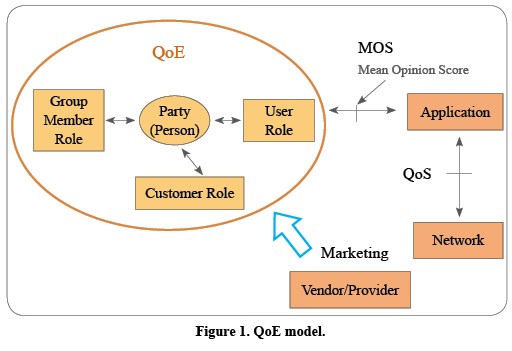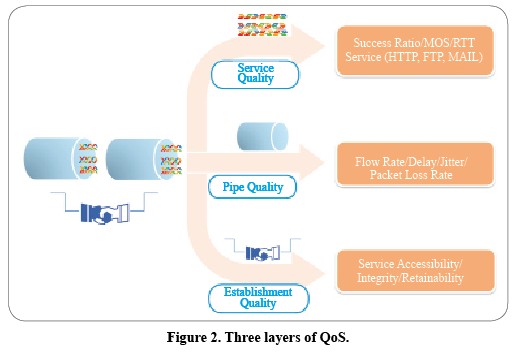Experience Economy Brings New Changes to Network OAM
The Transition from Network-Centered to User-Centered OAM
The internet economy is an experience economy; that is, network traffic, user stickiness, and business value can be enhanced by improving user experience. Even though operators have been affected by internet services and their profits have dropped, 70% of all operators can still survive merely as a pipe provider. The traffic that is generated by a large user base is essential for pipe providers. Communication pipes generally have very similar functions, and it is difficult to differentiate. Demand for network neutrality and fair access has also increased, so improving user experience is both a challenge and a top priority for operators to retain users and boost traffic. Marketing factors such as tariffs and service promotions affect quality of experience (QoE). Quality of service (QoS) is a technical indicator (Fig. 1) for measuring network performance. What users experience is the quality of an application, which does not necessarily reflect the quality of the network. It is the application itself rather than the network that provides QoE. In the mobile internet era, network-centered OAM is not sufficient, and user-centered OAM mode has become the trend.

Improving Maintenance Using Traffic Analysis
In the voice era, an operator’s network and applications were integrated in one physical entity. Operators could manage voice and SMS carried over their networks. However, in the internet era, an operator’s network and applications are separate. This makes it difficult for operators to manage their networks. Operators are challenged by how to determine customer experience, how to reflect service usage, and how to guarantee QoS. Factors affecting QoS include operator network equipment and lack of control over a large number of terminals, and non-self-operating internet services. Moreover, operators can no longer detect everything in a traffic model (as they could in the voice era) nor do they have a full plan of where the traffic will flow. New terminals and services result in new features in the traffic model. How to properly plan and deploy network resources is a new challenge for operators.
Traditional KPIs cannot reflect customer experience. In Fig. 2, the radio, bearer, transmission, and network parts are abstracted into a communication pipe. Traditional KPIs focus on accessibility, continuity, and integrity of the pipe and include RRC setup success rate and PDP activation success rate. The quality of the pipe itself is determined by the flow rate, average bandwidth, and delay. However, customers directly experience services. The speed and success of web surfing and video cannot be represented by KPIs. It is therefore necessary to deeply analyze traffic flow from user and service perspectives to assess QoE and QoS. In-depth flow analysis provides a data basis for quality enhancement, customer guarantee, and network architecture optimization.

Services used by customers can be analyzed through deep packet inspection (DPI); however, after such inspection, it is difficult to build a QoS model. In the 2G era, assessing the quality of CS services such as voice and SMS was not a problem. The message network at the CS control plane was perceptible, and KPIs for voice and SMS were abundant and specific. However, PS service assessment involves inspecting service type, managing messages associated with service establishment, and assessing quality of services. The cost is also relatively high. In practice, mapping QoS by the quality of pipe resources is another way to assess QoS. Although this is a simple way, a fault caused by a remote server or terminal cannot be located immediately. Therefore, building a simple and practical QoS model applicable to different scenarios is a continual process.
Optimizing multinetwork convergence—or 2G, 3G, 4G and WiFi multi-access—to enhance user experience has become a hotspot issue. The solution needs to include ways of choosing the best network without manual intervention and maintaining service continuity. A traffic flow analysis also needs to be done in network deployment and optimization. Such an analysis helps determine the ratio of 2G to 3G traffic flow, whether to deploy WiFi in order to offload cellular networks, and which services to deploy in hot spots. It also helps optimize network architecture, increase resource use, and enhance customer experience.
Much effort has gone into building cache, CDN, and IDC to speed up internet access and reduce the cost of exit bandwidth. However, duplicate content appears in the cache and IDC; the content of an IDC still goes out to be accessed by another network, and other content in the network cannot be used. These problems cannot be identified with traditional KPIs, but they can be identified using traffic flow analysis according to the destination IP address using DPI. Such problems can be solved by modifying a DNS configuration or introducing a smart DNS.
Optimized Management Based on Traffic Analysis
In the voice era, a business analysis system could help operators with precision marketing by analyzing voice call duration, toll traffic flow, bundling services, tariff, and SMS keywords. However, in the mobile internet era, operators might be operating blind if no in-depth analysis is done on their business.
Increasing effective traffic flow is the main target of the current business analysis. For precision marketing, operators need to determine customer characteristics and subdivide services. Their customers may be business users, migrant workers, news junkies, or music lovers. Services may be online shopping, video entertainment, or making friends. Different types of services are pushed to different customers. A video clip of Voice of China can be pushed to those who like downloading songs from the internet, those who have installed a karaoke/singing app, or those who often send MMS to friends at the concert. 360buy.com pushed its client software to those who often visited Taobao and SuNingyi purchase sites. To build a flexible QoS model, an integrated business analysis system is needed that can integrate all information from service analysis systems, CRM systems, and accounting systems in the network. Services also need to be pushed promptly through the service systems. The integrated business analysis system must be smart and operate on a real-time basis.
Differentiated business management is essential when network resources are limited. Differentiation is based on service awareness in the traffic flow. The biggest difference between mobile and fixed broadband networks is that a cellular network is constructed at high cost and is impossible expanded without limitation to meet growing bandwidth needs. To meet the needs of as many users as possible while working with resource constraints, operators have to choose between low-services, high-bandwidth services, low-priority users, and highly congested areas. They must make a portfolio strategy. They can satisfy most users at the expense of a small number of users.
Conclusion
Fierce internet competition has compelled operators to change their conventional network-centered OAM and gradually develop OAM that is focused on customer service. In-depth analysis of traffic flow allows continuous improvement in network maintenance, resource optimization, precision marketing, and the guarantee of customers.